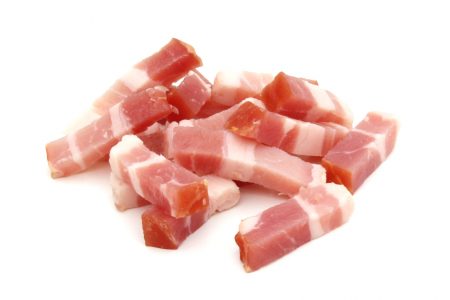HISTORY
Cooking tasty, original dishes in the blink of an eye is today’s daily challenge
The time devoted to preparing meals on a daily basis has reduced drastically in recent decades. However, in keeping with French gastronomic tradition, dinners and lunchtimes in the home still remain a focal point to come together and spend time with family or friends.
So to avoid feeling too guilty about cutting a few corners, all you need is a touch of creativity!

Lardons
Sometimes, all it takes to lift a dish to the next level is the perfect ingredient. And which food items go really well with vegetables, eggs, rice or even pasta, keep well – even when pre-packaged – for several weeks in the fridge, and bring a chef’s touch and creative flair to all your dishes? Charcuterie of course!
Bacon lardons, cooked or dry-cured ham, whether diced, in matchsticks or wafer-thin, meat stuffing, chorizo slices, bacon or dried sausage or even black pudding and sausages. And with a bit of imagination, there’s plenty more in the charcuterie range to join the creative cook-fest. Added at the last minute, charcuterie will brighten any dish.
And while perfectly suited to our busy lifestyles, these charcuterie culinary wonders have been around quite some time…
In days gone by, fat, meat stuffing and other charcuterie essentials, often closely-guarded secrets, were relied upon to bring an individual touch to a recipe and create unique flavour. The only major difference today is that these prepared meat kitchen essentials are ready to use.
Charcuterie cooking essentials are seeing huge success with the younger generations. And it’s not difficult to see why. Practical and super-quick, their success is largely driven by a penchant for concocting delicious food, lovingly enhanced and personalised to bring greater excitement, depth of flavour and all-round deliciousness, just like our grandmother’s cooking as we remember it. And because they are pre-packed, the other key advantage, lardons, ham in myriad forms and meat stuffing can be kept for several days, sometimes even weeks. Perfect for a last-minute change of plan, or if not eating at home on a regular basis. Not forgetting that charcuterie is rich in animal protein and of high biological value too. Bacon lardons, diced ham and other charcuterie cooking essentials are perfectly suited to a balanced diet.
THE ART OF PRODUCTION
True stars of kitchen essentials, bacon lardons are made from pork belly – in fact in France, more than 50% of pork belly is sold as lardons. And with improved trimming and selection, lardons are much leaner than in the past.
Once the meat is selected, the pork belly is boned then trimmed into a square. Other than salt, depending on the recipe, producers may also add herbs, spices, wine, alcohol or liqueurs*. Lardons can also be smoked. When thinly cut, they are known as lardon matchsticks (French: lardons allumettes).
Meat stuffing (sometimes known as forcemeat) is made from sausage meat, possibly mixed with finely chopped cooked meat, vegetables or fruit, and other ingredients including spices, fine herbs, alcohol, flavourings, truffle oil, salt and pepper. Perfect for stuffing seasonal vegetables…so don’t skimp!
FOOD PRESERVATION / STORAGE
Charcuterie cooking essentials, whether sold at the deli counter or on shelf, follow the same principles of production, and are made with the same exacting standards of quality and safety. Stringent food safety rules must be adhered to. Each stage in the production process for these charcuterie essentials, from slaughterhouse to packaging, is subject to rigorous controls. To meet these mandatory requirements, manufacturers have for a number of years introduced a number of measures, including Hazard Analysis and Critical Control Point (HACCP) system, staff hygiene training, and formulating and implementing a best practice food safety guide. Each product is identified by a lot number to guarantee traceability all the way through the production chain.
These high quality standards not only apply to producers. Other vital links in the chain – transporters and retailers – also comply with a comprehensive range of food safety rules to guarantee great taste and food hygiene standards. Charcuterie products are stored between 0 – 4°C at all times. In addition, retailers ensure charcuterie is handled with stringent hygiene procedures at deli counters.
SPECIALITIES
An extensive range of charcuterie cooking essentials…
Bacon lardons can be smoked or unsmoked, with or without rind, vary in fat content and texture, can be finely sliced or juicy dice. Ham too is not just about slices; it can also come diced, wafer-thin, in matchsticks and even grated!
And since these charcuterie essentials are ready-to-use, they are practical and a ultra-quick. Given the huge variety available, they are supremely versatile and meet a wide range of culinary needs. So as a rule of thumb, always keep a handy pack of lardons, diced ham and meat stuffing and other culinary essentials in the fridge.
And there’s something for everyone. While the health-conscious can opt for leaner diced ham without rind, the die-hard ‘authentics’ stick with smoked lardons, and ‘originals’ dabble with grated ham… Not forgetting sliced chorizo for an exotic touch and black pudding packed full of iron.
Innovative Packaging
First and foremost, packaging serves to guarantee the food’s intrinsic organoleptic qualities and keep the products safe for human consumption, while at the same time delivering practical solutions to suit a wide range of consumer needs.
Packaging for bacon lardons, diced ham and other charcuterie cooking essentials can vary from multi-pack to resealable packets for increased hygiene and less wastage. Nowadays, there is a preference towards handy, smaller packs that fit easily in the fridge, and tend to be single-serve portions.
